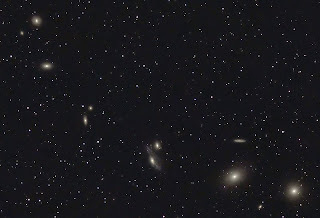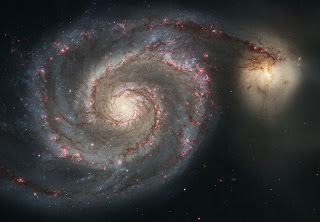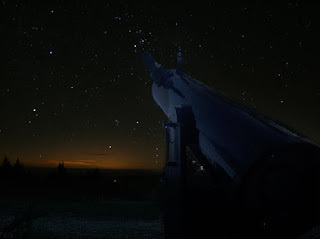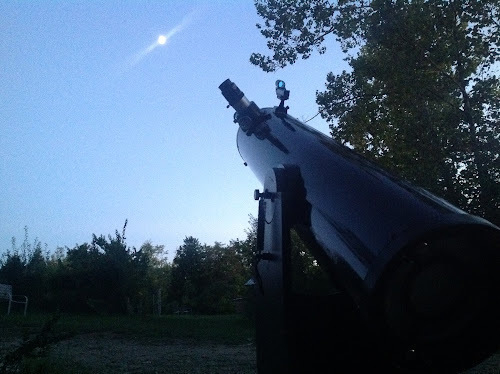Astronomy
- Did you use direct or averted vision?
- What is the overall shape?
- Is the core noticeable, compact, stellar ? Can structure be seen in the galaxy, mottling, bright or dark patches or lanes?
- Are the outer edges sharp or diffuse? Identify any other DSO in the field.
- Did you use direct or averted vision?
- Is the core bright, compact, or not distinguishable? Is it highly or loosely concentrated?
- Is any part of it resolved into stars, averted vision or not, or does it show mottling, or stars resolved at the edges?
- Identify any other DSO in the field.
- Is it easily distinguished from the background stars, is it well defined?
- Is there a overall shape?
- How many stars can you count in the cluster?
- Are the stars concentrated in any one area?
- Is the cluster fully resolved or is background nebulosity noticed?
- Are there areas where stars are absent in the cluster? Are there any brighter stars in the cluster and do
- any stand out in color?
- Identify any other DSO in the field.
- Did you use direct or averted vision to view the cluster and nebulosity, are filters needed? What is the overall shape?
- Are the outer edges sharply defined?
- Can both the cluster and nebulosity be seen with direct vision, or is averted vision or filters needed? What is the overall shape?
- Are the outer edges sharply defined?
- Are the stars concentrated in any one area?
- Is the cluster embedded in the nebulosity or is there a distinct separation?
- Is any part of the nebula brighter or more concentrated?
- Are there any voids or dark patches or lanes, bright filaments or streamers in the nebulosity?
- Identify any other DSO in the field.
- Did you use direct or averted vision? filters needed? What is the overall shape?
- Are the outer edges sharply defined?
- Is any part of the nebula brighter or more concentrated?
- Are there any voids or dark patches or lanes, bright filaments or streamers in the nebulosity?
- Is there an open cluster nearby or involved or any obvious stars involved with the nebulosity? Identify any other DSO in the field.
- What is the overall shape, is it disk shaped or more stellar?
- Are the edges sharp or diffuse?
- Is it easy or difficult to identify in the field?
- What is the color of the Planetary?
- Is the center brighter, darker or uniform brightness as the edges?
- Identify any other DSO in the field.
Observational Astronomy: The basic skills of science
I’ll be honest, when I ordered my telescope in September I had no idea what I was getting myself into. I had no agenda other than to have a way to look more closely at planets, galaxies and other objects in the night sky. Pretty simple really. After the first few sessions with the telescope I started thinking that I should keep track of the objects I was viewing. I started doing that but then realized I could probably be recording more than a simple list of what I was viewing. So I started keeping track of the date and time of the observations. Well, why not note which eye pieces I was using too? Ok. Check.
At the two week mark I’d done enough reading to see that there were organized observational “programs”, essentially, lists created to help guide and teach amateur astronomers how to go about learning observational astronomy. So I did a bit of checking and saw that in those programs they also record atmospheric conditions such as “transparency” and “seeing” as well as free form observational notes. Okay, why not?
Fast forward to today. I’ve been consistently recording each observation, 211 thus far, but realized that I was not recording much in the way of a free form description. Some people sketch what they see and I may try that in the future but for now I’d rather use words. The problem? I don’t really have the skills to properly describe what I’m seeing. More to the point, I don’t have the vocabulary which, in a sense, is also the instruction set for observation. The vocabulary is the framework. While this is just the most basic example of one step of the scientific method I think it is useful to recognize it as such. Amateur astronomy, if combined with just a little bit of discipline, can be a valuable experiential tool for learning observation skills.
So, I spent the morning searching around and have made some progress. Because I am a nerd I must of course share in the hopes that someone will find this useful. This particular bit of information is specifically helpful for the observation of deep sky objects. Planetary and other solar system observation of comets and meteor showers is a different set of concerns and techniques!
The below is just one page from a nice set of very informative pdfs over at Astronomy Logs.
Galaxies
The Whirlpool Galaxy
Even with the lighter sky I believe I was able to make out a hint of the spiral structure. M51 is not alone though, it has a neighbor galaxy, NGC 5195, with which it has been interacting for hundreds of millions of years. In fact it is believed that it is due to these interactions with NGC 5195 that the the spiral structure of M51 is so pronounced. Quite a pair!
In addition to the Whirlpool Galaxy I also got a look at two other Messiers, M89 and M90. I'll definitely revisit both of those when skies are darker. A bonus, the above mentioned NGC 5195 is a member of the Herschel 400! That brings me to 92 of 110 Messier objects and 112 of the 400 Herschels. Not to bad for just over two months of viewing!
Three months ago I would have told you that my brand new 8" Dobsonian telescope would be all I would need. Well, I can tell you, that as much as I enjoy the views that this scope provides, I am excited about someday seeing these objects with a 16" scope. So much of what is now a hint of structure will be far more obvious with a larger scope. That said, I'm happy to have started with the 8" and know that many people use such a scope for many years. It's good to know what is possible with this aperture and, in fact, learning to star hop with it has been a joy, viewing the faint fuzzies with it has required time and effort. I feel like I am earning my way to the next step and will, no doubt, more fully appreciate the better views of the larger scope when the time comes because of my starting point.
The Virgo Galaxy Cluster!
 |
| Messier 88 |
The Virgo Galaxy Cluster is about 54 million light years away and contains a minimum of 1,300 galaxies, possibly as many as 2,000. Viewing it with a telescope is fantastic... I just hopped from galaxy to galaxy. Normally I'm lost in the stars, this morning I was lost in galaxies! If there had been more time before the sunrise I could have easily stayed in this little area of the sky for many more hours. The number of galaxies is overwhelming.
 |
| Markarian's Chain |
My favorites of the night were Messier 88 in Coma Berenices as well as the various galaxies that make up Markarian's Chain. What a sight! Messier 88 actually shows a bit of structure though it is faint in my 8" telescope (and obviously nothing like the detailed image above).
I expect that my next 3-4 morning sessions will be spent in this cluster of galaxies. The moon will be setting later these next couple days so I'll have less time each day between moon set and sunrise. I hope to squeeze in another morning session tonight!
Astronomy Outreach at Antonia Middle School
This was my first time to attend a public star party and I'm happy to report it went over very well. I'd estimate attendance at 25-35 folks with 6 or so scopes and fairly clear skies. We had a bit of light cloud cover but it didn't last long. The area is subject to a bit of light pollution as well as a good bit of moon light but viewing brighter objects was no problem. I stayed on the Owl/E.T. cluster most of the night and am happy to report that everyone that viewed the cluster got a kick out of seeing the E. T. figure in the eyepiece! Other scopes were showing off Jupiter, the moon, and the Andromeda Galaxy.
All in all it was a successful event. I was thrilled to have a chance to meet several members of the SLAS. Of course I was quick to invite them all out to view from our dark skies in Madison County and am sure they'll take me up on the offer. I also received some excellent advice from one of the experienced members of the SLAS, John, on a few technical aspects of my scope. One of the great benefits of events like these are the opportunities for learning from more experienced members and I look forward to learning a great deal more from John and others. I'm also happy to report that I shared our efforts to build science literacy in Madison County via our Geek Parade and in discussing it with their members received at least one offer of a guest lecture/presentation to our group!
Stay tuned, more to come!
Viewing Jupiter and Saturn!
There is little doubt that when viewing planets in our solar system the two most likely to elicit a gasp of surprise from a first time planetary viewer are Jupiter and Saturn.
In recent weeks Jupiter has been rising at a time early enough to be high in the horizon by 9pm. If you view too early, 6pm or so at the time of this writing the planet is too low and will likely result in poor seeing conditions which means that air turbulence will cause a bit of blurriness and shimmering. If however you view later in the evening there is less turbulence and it is higher in the sky so what turbulence there is will be less. This is especially noticeable at the high magnification used for viewing planetary details. With my 8" diameter scope I use a 5mm eye piece which results in a magnification of 240x (this is figured by dividing the focal length of the scope by the eyepiece, in my case 1200mm/5mm=240x). This lens pushes the limits of my scope and unless seeing conditions are excellent my views are poor.
This past week I've had several occasions to view Jupiter and it has been a fantastic view each time thanks to excellent conditions. At high magnification I can view several distinct cloud bands as well as the Great Red Spot as well as several moons, usually four depending on the time.
Saturn is a bit more tricky at this time due to its position in relation to our planet's daily revolution. At the moment Saturn rises just before the sun in the morning and sets just before the sun sets which means that to view it you have to look to the south east just before sunrise and it will be visible to the naked eye below Venus which is by far the brightest object in the sky at that time. At 5:50am Saturn will look like a small star midway between the horizon and Venus. Through my 8" scope with the a less powerful eyepiece such as an 18mm the rings are visible but the planet appears fairly small. With the 5mm eyepiece and good seeing conditions the rings are easily visible and the overall image is stunning even in the bright morning light. In fact, I was still able to easily view the planet after it was no longer visible with the naked eye. Of course with a bright sky the color and details are not as clear.
Of course this changes with each day because Saturn rises earlier in relation to the Sun and within just a couple weeks will provide a much better view with a much darker sky. At the end of November Saturn will be easily viewable at 5:15am when the sky is significantly darker. Around November 26 and 27th Saturn will be passing behind Venus which should provide an interesting view! By mid December the planet will be well above the horizon by 5:15am and the sun lower which will provide an incredible view.
The Herschel 400
I’ve viewed 100 of 400 Herschel objects! For those that may not know, Herschel was an astronomer who cataloged several thousand objects in the universe. A fun way of learning the night sky is to work through a variety of such lists of objects. This is my second list to work on, the first being the 110 Messier objects. So, I’ve viewed 100 in about 9 days of viewing, I’m thinking I should have most of it done within the next month. What is great about these objects is that many of them are very faint (due to their distance from us, tens of millions of light years) and can be very challenging to find even if you are looking right at them.
Pondering the Future
Specifically my personal future and also thinking a bit about this blog. I’ve obviously not been very consistent with updates. Honestly, I put some of the blame for that on Facebook. I’m sure I am not the only one who spends too much time there. While it is great for sharing I thing the downside is that much of that sharing is just reposting. I am also leery of so much content being under one roof so to speak.
So, still here. With the crazy heat and drought of this past summer my garden suffered as did the many trees and bushes I put in over the past four years. That said, almost all of my perennials survived even if they didn’t thrive. Luckily the veggie garden was, by chance, smaller. The climate future looks increasingly scary for those of us that want to eat food, wink wink.
As for my project here, it will continue for the time being though I struggle to remain enthusiastic with the annual veggies. Something about three months of intense drought and heat seems to make my garden time outside a bit less enjoyable. Our well is shallow which means I either need to haul water from the lake or invest several thousand into a new well. Climate change is ugly.
So, I’m thinking that it is time to add in a new element of activity which reflects a new interest (actually a childhood/life interest that has been sitting in a corner of my mind): astronomy! Well, science in general, but astronomy especially. While I have no intention of abandoning the permaculture work I think having another primary activity is a good thing and in the winter when growing is out I’ll have something very interesting to explore, namely, our universe.
Which brings me back to one my thoughts on the blog. I’ve not been consistent in writing about my permaculture/homestead efforts but do think I might be more consistent in reporting on my astronomical explorations as it is the sort of interest that lends itself to data collection and reporting. Should I do that here as a supplement to my other interests or do I start an astronomy based blog? Actually, I think I just sorted it out as I write. I’ll keep it here but will not just add in my astronomical observations but will also add in other science related material.
Actually, and don’t laugh, but I have this vision of humanity (or myself?) that connects to a few episodes/films from Star Trek that have always stuck with me. In particular, those which seem to showcase small, egalitarian villages in which science seems to not only co-exist with daily life, but informs a deeper and greater understanding of the relationship between humans and nature and the larger universe. Contrast this to our modern manifestation which seems to have largely become a tool for corporate profit with little regard to ethics. A great example would be GMOs and modern industrial agriculture as it might compare to a decentralized permaculture-based system informed by local and thoughtful observation.
One outlook, the modern corporate/capitalist/industrial, uses science primarily as a tool for the accumulation of wealth. The other uses science as a method for deepening our understanding of the natural world around us not just for technological development, but for the sake of understanding. In this second outlook the ethics of use would be an important part of the overall process and would include all sorts of new questions and concerns in any sort of possible application of scientific knowledge. In fact, one might say that the second view represents a kind of democratization of applied science.
Wow. I didn’t expect to take this post in this direction but it is interesting and it is something I’ve thought about off and on over the years so, yeah, I’ll be back to this at some point. Another area that I’d like to explore is science literacy and critical thought. There has been a long trend in the U.S. which seems to be gaining a bit of steam when, in fact, it should be losing steam and that is the movement against science. Such a movement can only happen when there is a lack of communication of knowledge. When people are ignorant of established scientific knowledge and the basic method which serves as its foundation there is room for manipulation.
So, you can expect that I’ll be spending some time discussing not just science but specifically science literacy. I’m not a trained scientist but I think I know enough to discuss some issues as a citizen. Specifically I’m likely to dig into the entwined relationship of politics, religion and global capitalism have been used to undermine science literacy to further their capacity as control agents: social, political, economic, ecological… everything from the genetics of corn to humans, from crowd control to the “entertainment” that comes out of the glowing screens in living rooms. Science and technology can be used in many ways for many different and often opposing agendas. I think that will be some interesting exploration.
There is also some real life stuff I’m hoping to make happen that reflects all of this, specifically a few ideas for how I might further science literacy here in rural Missouri where it is greatly needed. I’ll share that as well.
Stargazing from the front yard
The cool thing about astronomy? It is also time travel! Did you know that when you look into the night sky your eye is being hit by the actual photons that were put forth by the stars you are looking at? We are connected to those stars through those photons, some of which have been traveling to us for many thousands of years. Look at a neighboring galaxy such as Andromeda and your eyes are connecting with particles that have traveled for 2.5 million years, 5.8 trillion miles each year, and they finally meet you and your eyes. How fantastic is that?


